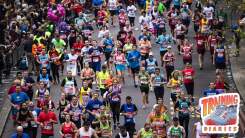Meredith’s Training Diary: Nothing New on Race Day

Welcome to Training Diaries, a new Lifehacker series about my journey to the 2023 TCS New York City Marathon. This series will cover all the ups, downs, and hill repeats on my journey to the biggest marathon in the world. Leading up to race day on Sunday, Nov. 5, I’ll go over proper fueling, injuries and setbacks, treadmill tips, wardrobe malfunctions, long run logic, and just generally reflect on what it takes to cross a marathon finish line. I’m guided by a mantra both corny and true: A marathon is actually hundreds of miles; race day just happens to be the last 26 or so.
With race day less than two weeks away, I’m in the thick of the anxiety-inducing marathon taper. As I detailed in my last post, one of the best ways to redirect your pre-race nerves is through planning race day. It’s funny, the way marathon planning begins to feel like planning a vacation. Even figuring out transportation to the start line feels akin to prepping for the airport. You’re meticulously accounting for what you wear, what you’re going to eat along the way, what emergencies could pop up.
With so much on the line, and so many nerves with nowhere to go, it may be tempting to try something exciting and new—before or during the race—to gain an edge. Perhaps some fresh kicks, or an expensive new fueling strategy. However, most running experts advise sticking with what you know to avoid race day mishaps. This tip can be boiled down to a familiar running aphorism: “Nothing new on race day.”
My first marathon, I was young and cocky. This is very different from who I am today: Young and humble. And perfect! Although I had heard the “nothing new on race day” advice, I assumed it really only applied to fueling and shoes. I wanted to wear the brag-worthy new race shirt that I had picked up along with my bib. I mean, they were made for each other, right? Unfortunately, my shiny new shirt had a too-high neckline that started irritating me around mile seven, and it didn’t quit bugging me until I tore it off after the race. It sounds like a minor detail, but it colored the entire race experience for me. When you’re running a marathon, you want to be able to focus on the mile you’re in. Not the unbearable chafing going on god-knows-where.
The moral of the story: Your excitement to try something new will lead to some light self-sabotage. Here are all the variables that might tempt you to try something new on race day, and how you must resist their charm.
How to follow the nothing new on race day rule
Here are some tips for following the “nothing new on race day” rule.
Pick a fueling regimen and stick to it
Race day nerves can wreak havoc on your digestive system. Introducing anything new could lead to GI issues that ruin your race. Stick to the routine that has worked for you in training and trust in your preparation.
This means sticking to your normal pre-race breakfast and your usual training snacks and hydration. Don’t try new energy gels, drinks, or solid foods right before or during the race.
I can’t emphasize this enough: You must experiment during training runs to see what your stomach can comfortably digest. The sugars and electrolytes in most gels and sport drinks can cause gastrointestinal distress if too much is consumed at once. If you didn’t try it out on a run during your training, do not even think about trying it out during your race.
Here’s my full post on proper marathon fueling.
Get your gear ready early
Chafing is so real, and so painful. Wear the same shoes, socks, shorts, shirt that you’ve trained in for long runs. Don’t debut a new GPS watch or heart rate monitor. If you’ve never run a marathon before, you’ll be surprised to find how much gear can affect your mood during the race. I consider myself a pretty chill person, but a too-tight hat, or too-lose earbuds, or itchy sock will turn even the chillest amongst us into whiny monsters by mile 20 or so.
Plan your course strategy
Run the pace and splits you’ve trained for. Resist the urge to bolt out too fast or deviate from your plan mid-race. This tip that applies to all races, but applies to the NYC marathon more than most races: Go slow. From the adrenaline of crowds cheering, to the pressure from over 40,000 fellow runners, it’s tough not to accidentally speed up. But going too fast right out of the gate will screw you over by mile 20. Here’s my post on the power of what I call “cruise control” running.
Plan your recovery strategy
Have the same post-race fueling and hydration strategy you used during training for long runs. Don’t try new protein powders or recovery drinks.
Trust the process
The bottom line: Marathon training is all about trusting the process. But for the process to be remotely trustworthy, you have to control the controllable. The race course itself will be new on race day—don’t make your gear, fueling, or strategy brand new too. Follow the “nothing new on race day” rule so the only surprises are how good those cheers from the crowd feel at the finish line.



